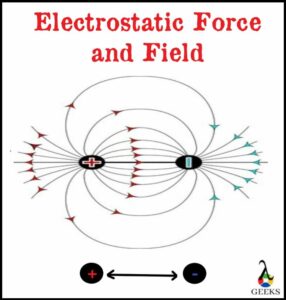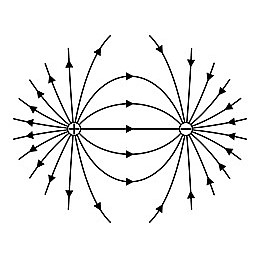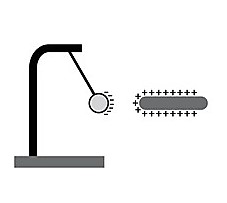The electrostatic force is developed under the physical field called the electric field, which surrounds the attracting or repelling charges. The article discusses what electrostatic force and field are and how they are related.
Every charge is enclosed by its field or energy distribution that transmits its electric properties through the spaces to other charges. That’s how the field of one’s charge approaches other charges, and once they are brought closer, they exert electrostatic force without physical contact.
In previous articles, we have learned about the gravitational force between two interacting objects having mass. To exert the gravity force, there must be a field surrounding the earth, and it’s all other masses so that when another mass attains that field, both masses experience gravity force. Similarly, the electrostatic force, a non-contact force, exerts between two charges when they are in the electrostatic field. It is because gravity and electrostatic force follow the inverse-square law when two masses are separated by distance.
The electric field is the electric charge’s property present at every point in space. The magnitude of the direction of the field is called electric field strength or field intensity which is different at different points within the space. The field varies with charge, but since it is originated from the Coulomb inverse square law of distance, the field inversely changes with the square of the distance from the charge. That means if we double the magnitude of charge, the field gets double. But at twice the distance from the charge, the field is one-quarter of its initial strength.

The electric field is pictured by drawing lines, termed as the field lines around the charge. The field direction shown by an arrow is along with the electrostatic force. The magnitude of the electric field depends upon how the charge is distributed into space.

(credit: shutterstock)
We have understood that the electrostatic force is exerted between two charges at a distance. But instead of two, we consider one charge as the ‘source charge‘ from which the electric field developed. The other charge brought into the field of the source charge is termed as ‘test charge’. Due to indirection electric interaction between electric field and test charge vie source charge, the electrostatic force employed from source charge into test charge as per Coulomb’s law.
The test charge also carries its electric field that alters the existing field of the source charge. Hence, the point source employs the electrostatic force to source charge under its electric field. So that the resultant electrostatic force between two charges increases.
The direction of field lines depends on the charge’s polarity. The neutral charges do not create field or field lines around it. If the source charge is positive, its field lines are directed radially outwards. If it is negative, then they are directed radially inwards.
- If both charges are like or positive and positive or negative or negative, the field lines of their respective field never coincide as they repel each other.
- If they are unlike or positive and negative charges, their field lines coincide as they attract each other.

(credit: shutterstock)
In a case of unlike charges, the radially outward field line is incorporated into radially inwards lines of the negative test charge on which the electrostatic force is exerting.

Read more about Electrostatic Charge.
Electrostatic Force and Field Example
Suppose we attach a positive test charge at the rod’s end. By carrying the stick at a diverse location, we can experiment with the electric field of test charges at various points.
We then experience the push or pull on the rod as the test charges attract or repel other charges due to electrostatic force. If we move the source charge away from the test charge, its electric field will remain the same at that point.

(credit: shutterstock)
Hence, the electric field distributes the electrostatic force by the source charge into a small test charge at different points within space.
Lightening arises from the electric field between the cold storm clouds and the hot earth’s surface. Electrically charged regions provoke lightning due to electrostatic discharge through the air, which acts as an insulator between two regions. When the insulating capacity of air that holds the opposite charges shatters down, instantaneous electricity discharge happens in the form of lightning.

(credit: shuttertstock)
In the earlier process, intra-cloud lightning occurs when charges stay within the cloud when the electric field strength of both regions is equal. Later on, when the earth’s ground’s field strength became stronger than the clouds, the charges initiated reaching the earth’s ground, leading to cloud-to-earth lightning.
Read more about Types of Forces.
Relationship between Electric field and Electrostatic Force
The electric field and electrostatic force are related by the magnitude of the test charge.
The electric field E of the source charge is the electrostatic force F per unit of test charge q. So, the electric field decreases as the distance increases radially away from the source charge. It is described by the electrostatic force at distinct points using the Coulomb law Inverse Square formula.
The electrostatic charges exert force without having physical contact. So we can imagine there is an electric field existing around both charges for its electrostatic exchanges. In such a case, the force is real, whereas the field is imaginary.
Since the electric field is the vector quantities, it has different intensities at different points within space. Hence, the force exerted by the source charge changes from these point to point.
The electric field and electrostatic force are related as,
Hence, an electrostatic field’s measuring (SI) unit is Newton/Coulomb (N/C).
Let’s analyze the electric field due to positive source charge Q exerting the electrostatic force F on two different test charges at the same distance r from charge Q.

- If the test charge q1 is positive, their field lines are directed radially away, and the electrostatic force between them is repulsive.
- If q1 is negative, their field lines are directed radially towards each other, and the electrostatic force between them is attractive.
From both points, the electrostatic force F depends on both charges, even when exerted by one to another within the electric field.
The electrostatic force between charges is the product of the electric field and test charge magnitude, and it is given by,
From equation (*) and (1), we learn the electric field F and electrostatic force is in the same direction.
The electrostatic force due to Coulomb law of attraction or repulsion is,
From equation (*), the magnitude of electric field E is given by,
Using equation (2),
The above equation shows that the electric field E depends on the source charge Q and its distance r. Whereas the test charge q is tiny, it does not vary source charge distribution, building its electric field.
Electrostatic Force and Electric Field Problems
Suppose the source charge of 10nC is separated from the test charge at 10m. What is the magnitude of the electric field of the source charge? (ke = 9 x 109Nm2c-2)
Given:
Q = 10nC = 10 x 10-9 C
r = 10m
ke = 9 x 109 Nm2c-2
To Find: E =?
Formula:
Solution:
The electric field between charges is calculated as,
Substituting all values,
E = 90/100
E = 0.9
The electric field of the source charge is 0.9 N/C.
Suppose both charges of 5nC are interacting away from each other at 5m. What is the electrostatic force between interacting charges? Calculate the electric field.
Given:
q1 = 5nC = 5 x 10-9 C
q2 = 5nC = 5 x 10-9 C
r = 5m
ke = 9 x 109 Nm2c-2
To Find:
- F=?
- E =?
Formula:
- E = F/q2
Solution:
The electrostatic force between charges is calculated as,
Substituting all values,
F = 9 x 10-9
The electrostatic force between charges is 9 x 10-9N.
The Electric field between charges is calculated as,
E = F/q2
Substituting all values,
The electric field between charges is 1.8 x 10-9N/C.
In a parallel plate capacitor, two plates are separated by a dielectric medium at a distance of 5cm. If the electric field between charges developed on the plate is 2N/C. Calculate the electrostatic force between them if both charges have the same magnitude.
Given:
E = 2N/C
r = 5m
ke = 9 x 109 Nm2c-2
To Find:
- q1 =?
- q2 =?
- F =?
Formula:
Solution:
The magnitude of source charge is calculated using the Electric Field formula.
Substituting all values,
Rearranging,
q1 = 5.5 x 10-9
Both charges have the same magnitude. i.e., q1 = q2 = 5.5nC
The magnitude of both charges is 5.5nC.
The electrostatic force between both charges is calculated using Coulomb law.
Substituting all values,
F = 10.89 x 10-9
The electrostatic force between charges is 10.89 x 10-9N.
Read more about How to Calculate the Force.
Difference between Electrostatic Force and Electric field
| Electrostatic Force | Electric Field |
| It is generated when two interacting charges come close to each other. | It is generated from only one source or point charge. |
| It accelerates the charges. | It does not accelerate the charges. |
| Its magnitude and direction depend on both source and test charges. | Its magnitude and direction depend only on the source charge. |
| It is the ratio of the product of charges to the square of the distance between charges. | It is the ratio of the electrostatic force to the test charge. |
| Its Coulomb formula is, |
Its Coulomb formula is, |
| Its measuring unit is Newton (N). | Its measuring unit is Newton/Coulomb (N/C). |
Also Read:
- Is magnetic field and magnetic force same
- Is electrostatic force conservative
- How to find net force with mass and velocity
- Coriolis force example
- Centrifugal force vs coriolis force
- How to find normal force with mass and acceleration
- Is muscular force a contact force
- Is magnetic flux a magnetic force
- How to find normal force with acceleration
- Force on moving charge in magnetic field

Hello, I’m Manish Naik completed my MSc Physics with Solid-State Electronics as a specialization. I have three years of experience in Article Writing on Physics subject. Writing, which aimed to provide accurate information to all readers, from beginners and experts.
In my leisure time, I love to spend my time in nature or visiting historical places.
Looking forward to connecting you through LinkedIn –